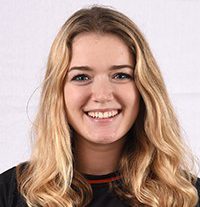Students

Natasha Skov
Psychology and Computer Science, 2020

Brooke Hershberger
Sociology and Entrepreneurship, 2019
Project Description
The purpose of the GARDEN project is to provide a sustainable, small vertical garden for any apartment, patio, or kitchen space. While our EPICS project is only a miniature version, our prototype is able to be expanded to any size in order for many pallets to be reused. This miniature version serves the purpose of fitting on a desk, or some small office space. The miniature EPICS version is 12” by 10” and features a drip irrigation system, operated by the user. Inside the pallet, there will be a tarp to hold the soil and plants. The drip irrigation system is made of plastic tubing with drilled holes to drip out of. Below the pallet, there is a 3D-printed drip-tray that the water both comes out from and catches in. This way, the pallet is both sustainable and user-friendly. The garden currently contains succulent plants in order to assure their survival during transport and assembly. Once we can assure it functions perfectly, we will begin to plant herbs and edible plants to use in the kitchen. The GARDEN miniature recycled pallet garden will be a great, sustainable addition to any office, kitchen, flat, or outdoor space.
Technical Background
Our project involved many technical pieces from 3D printing to drip irrigation. A technical piece overlooked is the garden itself; what plants we chose to use. Because our garden is for an indoor office space, we chose to use succulents which are incredibly durable and can tolerate limited watering. This plant bread requires less watering than average plants. This means that in an indoor setting where it may be forgotten or overlooked and have little access to natural rain it will still be able to thrive. Because succulents can collect and hold onto rain water, they are resistant to drought (or a careless owner). Succulents also are unique in that they actually need less attention in the Winter months. They grow very little in the Winter months and require less water and sun, then in the Spring and Summer months wake and begin to grow again and some succulents will even bloom. Succulents are also ideal for this type of planted because they absorb their water from the soil rather than the roots. Many plants absorb water from their leaves as well but the key to succulents is getting the soil moist. Ideal for indoor gardening. A beneficial feature of the pallet style versus a pot is the spacing of the succulents. One thing succulents do need is room to breath and the pallet forces them to be spaced out evenly with enough room for fresh air.
Another benefit to growing succulents indoors versus out is their tendency to dislike temperature change. A consistent temperature is the ideal setting for a succulent making them the perfect house plant and the perfect miniature-vertical garden plant. If this EPICS project were enlarged and became an outdoor planter other plants would be considered based on the environment and seasons..
HowStuffWorks.com Contributors “How does drip irrigation work?” 15 June 2011. HowStuffWorks.com. <https://home.howstuffworks.com/drip-irrigation.htm> 17 March 2019
3D Printing “What Is 3D Printing? How Does a 3D Printer Work? Learn 3D Printing.” 3DPrinting.Com. <3dprinting.com/what-is-3d-printing/> 17 March 2019
Design Drawings
Fabrication Process
Lorem ipsum dolor sit amet, consectetur adipiscing elit. In elit augue, commodo vitae ante maximus, mollis porttitor nunc. Nulla mollis arcu arcu, eget vehicula orci cursus id. Pellentesque finibus dui turpis, eget mollis risus rhoncus at. Sed mollis tempus mattis. Integer tincidunt nec urna rutrum eleifend. Aenean sapien erat, sagittis ut nulla non, ultricies egestas purus. In tincidunt tellus a justo consectetur, sit amet suscipit risus mollis. Pellentesque varius dolor vitae ex fermentum dapibus. Suspendisse efficitur, massa at scelerisque convallis, neque velit congue tellus, vitae interdum risus tellus sit amet augue. Praesent viverra risus eget turpis iaculis porttitor.
To begin assembling our garden, we used the completed prototype from our first semester project. This prototype is a 10” by 12” miniature wooden pallet, assembled completely from recycled wood found in the EPICS laboratory. The pieces of the pallet were cut by using the Jigsaw, and are held together with glue. On the backside of the pallet, there are two screws that can be used to hang the garden on the wall, if the owner would like it there. The next step we took to creating our miniature vertical garden was spray painting the pallet white to give it a polished look. This was done in two sessions for two coats of paint.
Next, we printed our drip tray. The tray holds the pallet up exactly, so that the pallet can sit right on top of the tray. We used the 3D printer in the epics laboratory, and the tray took 24 hours to print. The tray has a small side container to hold the water supply for the drip irrigation. After printing the tray, we created the drip irrigation system. This was done by using ½ inch tubing. We cut the length of the tube to equal the height and width of the pallet. This way, it could be extended to fit from the side container of the tray to the top of the garden. We had to puncture drip holes in the tubing, each about an inch apart. At the end of the tube (the top) we super-glued a stopper to the end, to prevent any spilling. This end of the tube is attached to the pallet by fitting through a screw eye bolt, which is screwed into the top of the pallet. To fold the tube over the corner, we used a plastic elbow push over the corner of the garden. The tubing goes through this, and carries down into the water supply. This end of the tube is glued to the screw top of a 3oz silicone container (the water supply). When screwed together, the water can be squeezed from the silicone container and flows through the tube and drips out of the holes.
Next, we lined the pallet with landscape fabric to hold all the soil in, but still enable plant growth and drain water. We cut the fabric and attached it with super glue. Once this dried, we filled the garden with a combination of peat moss. Next, we purchased succulent plants and moss to be put in our garden (mainly for display and the presentation!). We placed the succulent plants in the garden, and decorated with moss around the plants. To water the garden, one simply has to squeeze the water supply and watch the water drip!